

 Lewelling Vineyards are an integral part of Napa Valley’s rich viticulture history. Patriarch John Lewelling was born in 1811 in North Carolina and was one of 8 children. The original spelling of their family name was Lewallen. In 1850, John migrated west from Iowa to California along with thousands of others and briefly worked in the gold fields near Placerville during California’s Gold Rush. Never making it rich in the gold fields, he returned to his agricultural roots; eventually he settled in San Lorenzo (San Francisco Bay Area) where in 1855 he established a very successful nursery and orchard business. John was not the only horticulturist in his family – his father was in the business and so were his three brothers. One of his brothers, Henderson migrated to Oregon with a wagon full of grafted fruit trees (the plant material he transported eventually became the starter material for a number of fledgling nurseries on the Pacific Coast. And incidentally Henderson later established the community of Fruitvale in the east bay (Oakland).
Lewelling Vineyards are an integral part of Napa Valley’s rich viticulture history. Patriarch John Lewelling was born in 1811 in North Carolina and was one of 8 children. The original spelling of their family name was Lewallen. In 1850, John migrated west from Iowa to California along with thousands of others and briefly worked in the gold fields near Placerville during California’s Gold Rush. Never making it rich in the gold fields, he returned to his agricultural roots; eventually he settled in San Lorenzo (San Francisco Bay Area) where in 1855 he established a very successful nursery and orchard business. John was not the only horticulturist in his family – his father was in the business and so were his three brothers. One of his brothers, Henderson migrated to Oregon with a wagon full of grafted fruit trees (the plant material he transported eventually became the starter material for a number of fledgling nurseries on the Pacific Coast. And incidentally Henderson later established the community of Fruitvale in the east bay (Oakland).
And John’s own initial supply for his nursery came from trees he had shipped from back east as well as from his brother’s nursery in Oregon. John’s nursery and eventually 100 acres of orchards supplied both fruit trees and various fruits to customers in the region. He was well known for his cherry trees and at one point had the largest cherry orchard in the state of California. John Lewelling’s business was named J. Lewelling and Sons – referring to his two boys, Eli and Elisha who were part of the operations.
Lewelling Boulevard off of the 880 freeway in San Lorenzo was named after him. And just north of Lewelling Boulevard is a small community called Cherryland with Cherryland Park and nearby Cherryland Elementary School. Blossom Way runs through the heart of this neighborhood. These names are all tied to early agricultural pioneers including William Meeks who was a contemporary of the Lewelling’s and at one point was in business with Henderson Lewelling owning and operating a nursery and sawmill in the Willamette Valley in Oregon. The Meeks Mansion and gorgeous grounds in Cherryland is highly worth visiting. The mansion dates from 1869, a giant mulberry tree long since fallen but still growing is surrounded by a fence, and a small apricot orchard still grows. Walking onto the grounds is like walking back in time.
Cherryland
Cherryland Park
Meeks Mansion & Grounds
Lewelling Namesakes
Lewelling House Museum
The Lewelling House Museum is located in tiny Salem, Iowa. A visit here is an important look back into two primary factors associated with this particular house, the Lewellings anti-slavery stance and its prominence as home to Iowa’s first commercial nursery. Henderson and his wife Elizabeth were early residents of this Quaker community, settling here in 1837 after moving from Indiana (for perspective that is only a year or two before George Yount planted the first grapevines in Napa Valley). This home, now museum was built by the Lewellings in 1843 and was a stop on the Underground Railroad (a trap door and a tunnel are built into the house). The museum is open on Sundays from 10-4pm May through September or by walk-in or other days by appointment (at least 24 hours’ notice is required).
Lewelling House Museum, Salem Iowa
Salem, Iowa
—
John sold his business to his son Eli and moved to St. Helena in 1864 for health-related reasons (looking for a drier climate to fight his asthma) and purchased his first property and in the subsequent years planted several hundred acres of vineyards. By 1868 he owned 400 acres of land in Napa Valley. Along with other St. Helena viticulture pioneers including Charles Krug and Henry Pellet, John Lewelling helped found the St. Helena Viticultural Club (the precursor to today’s Appellation St. Helena).
In 1870 he built an impressive Gothic revival style home for his family; this home is also still standing. When phylloxera infected his vineyards, John planted a variety of other crops (chiefly walnuts and almonds) as well as stone fruits. He also built a dehydrator on site for drying fruit including processing grapes into raisins. Much later, John’s grandson Raymond Lewelling built and maintained a dehydrator on property from the 1950s through the 1970s. According to an article in the September 28, 1962, issue of the Napa Register, the Lewelling dehydrator was processing walnuts from between 100 and 130 growers each year and could process up to 1,000 boxes of walnuts per day. In the early 1960s there were about 2,000 acres of walnuts planted in Napa Valley.
In 1876 John built the Lewelling Winery on the south side of Spring Street in St. Helena about three blocks west of Main Street (no longer being used as a winery but the building still stands at 1635 Spring Street and is a part of a residential site). A prominent vineyardist, Simon P. Connors built a stone cellar in 1884 on site of what is now Frank Family Winery. After selling the property and cellar in 1887, that same year he leased Lewelling Winery for several years for his winemaking operations.
When John Lewelling died, the California Horticultural Society declared him to be “The Father of California Horticulture”.
And it was John who sold 4.5 acres in 1874 to John Thomann, who soon built the Thomann Winery and Distillery located just south of St. Helena. This site and winery eventually became the original Sutter Home (the name that the Trinchero family kept when they acquired this property in 1947). And it is still where Sutter Home hosts tastings.
John Lewelling Grave, San Lorenzo Pioneer Cemetery
Fast forward many decades. The mid to late 1970’s was a time when Napa’s wine industry was just at the cusp of taking its vineyard production and quality to the next level. For perspective, today less than forty wineries are still producing wine who were in business in 1975 or prior. Reference the list we have curated through extensive research here. Lewelling Vineyards while growing wine grapes in the mid 1970’s – still had much of the property planted to other crops including cherries, prunes and walnuts.
It was around this time that Doug Wight moved back to Napa (John’s great, great grandson) after earning a degree in Fruit Science from Cal Poly San Luis Obispo. He helped manage vineyards for the historic Louis Martini Winery before starting his own vineyard management business.

 Lewelling Vineyards farms one of the oldest continuously-owned family vineyards in the Napa Valley. What is just as remarkable is that the Lewelling family has stayed true to their strong agricultural roots generation after generation. The fifth and sixth generations are now running Lewelling Vineyards, and the seventh generation is already running among the vines. David Wight is the primary winemaker, and his brother Doug has built a successful vineyard management company and has farmed the family property for the last 40+ years. Today Wight Vineyard Management company manages 500 acres of vines in Napa Valley.
Lewelling Vineyards farms one of the oldest continuously-owned family vineyards in the Napa Valley. What is just as remarkable is that the Lewelling family has stayed true to their strong agricultural roots generation after generation. The fifth and sixth generations are now running Lewelling Vineyards, and the seventh generation is already running among the vines. David Wight is the primary winemaker, and his brother Doug has built a successful vineyard management company and has farmed the family property for the last 40+ years. Today Wight Vineyard Management company manages 500 acres of vines in Napa Valley.
And their vineyard is located in one of Napa Valley’s historical who’s who of vineyard neighborhoods, each vineyard with its own fascinating and extensive history. Some include the Hayne Vineyard, Dr. Crane Vineyard and the old Edge Hill property.
Doug’s daughter Haley (John’s great-great-great-granddaughter), moved back to the valley and became a winemaker; she and her husband have their own wine brand, Hayfork. She says, “As a child I roamed my family’s ranch with a sense of freedom most children today are denied. I explored creeks, climbed trees, picked berries and walked through vineyard rows searching for arrowheads. I was grateful to know the land, but in my innocence did not realize how quite fortunate I was.” It is this connection to the land that is so valuable during one’s formative years – you develop respect for the land and when it physically sustains a family through agriculture for generations – that respect is passed on and you become its steward.
The vineyard is eighty planted acres located at the base of the Mayacamas mountains in St. Helena. Because of its proximity to the slopes, the vineyard has benefited from thousands of years of soil erosion coming down from the hillsides. While the soils are not nearly as deep as further out in the valley floor, quantity of production is not necessarily as important when your focus is on making premium wine. For this type of wine, these alluvial deposits/bench land type soils are ideal. This part of Napa is one of the sweet spots for growing high quality Cabernet Sauvignon.
Because their production is so limited only a small percentage of their entire vineyard is sourced for the Lewelling wine. The fruit from the rest of the vineyard is highly sought after by a number of premium producers in the valley including Caymus and over the years they have also sold to Beaulieu Vineyard, Markham and Viader. The family also owns another 200 acres above the valley floor, with much of it is still in its natural state.
Lewelling Vineyard
Lewelling Winery, Helvetia Cellar, Spring Street St. Helena
Select Wines
The first commercial release of Lewelling was from 1992. Lewelling’s production is fairly small each year – typically around 1200 cases. They focus on two wines; a Cabernet Sauvignon and a reserve barrel selection called the Wight Vineyard Reserve. Some years a small amount of Cabernet Franc is also blended with the Cabernet Sauvignon. The wines are bottled unfined and unfiltered.
Lewelling Vineyards Cabernet Sauvignon
The 2021 Lewelling Vineyards Cabernet Sauvignon is deep ruby and opaque; it is 100% varietal and was aged for 20 months in 75% new French oak barrels. There is nothing shy about these aromatics; upon opening they are immediately dark, sweet, ripe and generous. They include scents of blackberry, black cherry, boysenberry spread, chocolate brownie, and additional layers including a note of crushed peppercorn and mint. Bright, rich and layered in terms of both flavor and texture, this wine delivers plenty of pleasure in its youth. The palate reveals flavors of blackberry, cassis, mulberry and prune (dried plum), with a lingering note of dark chocolate. The firm and persistent tannins are Lewelling textured and similar to other vintages we have tried, are grainy but more rounded than angular. This wine finishes rich with loads of ripe berry-like fruits, a light toasted oak nuance and a lasting dryness.
 The 2020 Lewelling Vineyards Cabernet Sauvignon (100% varietal) was aged for 20 months in 75% new French oak barrels. This wine is deep ruby and nearly opaque in the glass; the aromatics are open-knitted and immediately expressive upon opening; their focus is clearly on fruit with oak playing a lighter and complementary role. They offer scents of blackberry jam, boysenberry and ripe Santa Rosa plum accompanied by layers of mocha, espresso, Graham Cracker and a subtle red chili spice. The palate offers a mouthful of fresh fruit including flavors of dark plum, cherry, blackberry, boysenberry and black licorice. Ripe but not jammy. At this age, 3 years post vintage, the tannins are somewhere between grainy and chewy in their textural feel. Broadly distributed across the palate, they linger for quite some time, ultimately outpacing the fruit with a drying character.
The 2020 Lewelling Vineyards Cabernet Sauvignon (100% varietal) was aged for 20 months in 75% new French oak barrels. This wine is deep ruby and nearly opaque in the glass; the aromatics are open-knitted and immediately expressive upon opening; their focus is clearly on fruit with oak playing a lighter and complementary role. They offer scents of blackberry jam, boysenberry and ripe Santa Rosa plum accompanied by layers of mocha, espresso, Graham Cracker and a subtle red chili spice. The palate offers a mouthful of fresh fruit including flavors of dark plum, cherry, blackberry, boysenberry and black licorice. Ripe but not jammy. At this age, 3 years post vintage, the tannins are somewhere between grainy and chewy in their textural feel. Broadly distributed across the palate, they linger for quite some time, ultimately outpacing the fruit with a drying character.
The 2018 Lewelling Vineyards Cabernet Sauvignon (100% varietal) was aged for 20 months in 70% new French oak barrels. This wine is dark ruby, showing purplish tinges along the rim of the glass. Offers forward fruit powerful aromatics including of ripe dark cherry, black licorice, dried rose petals and cassis. The bouquet also shows an underlying savory component including aromatics of leather, old cedar box, smoked meats and dried herbs. As it evolves notes of mocha are revealed. Definitely features darker aromatics and definitely makes its presence felt. This wine is ripe, rich and generously layered with an intensity of darker fruit lasting the entire breadth of the palate. Lingers with plenty of fruit along with old cedar box, a hint of dried tobacco leaf, crushed peppercorn and broadly distributed but integrated tannins. Shows plenty of life in its youth, but without any sort of overly boisterous tannins. This wine was aged 20 months in 70% new French oak barrels. 950 cases were produced.
Wight Vineyard Cabernet Sauvignon
 The 2021 Lewelling Wight Vineyard Cabernet Sauvignon is 100% varietal; it is deep ruby and opaque in the glass. This wine offers an attractive union of both ripe fruit and baking spices. These include scents of Graham cracker, clove, cardamom, nutmeg and chocolate. But like all the Lewelling bottlings there is plenty of fruit to go around with aromas of blackberry, boysenberry and dark cherry. The barrel influences, at least on the bouquet are more pronounced in this vintage than the 2020. This wine drinks very well in its youth and despite its young age at the time of our tasting already shows a pleasing balance and tension between fruit and texture. The palate offers flavors of dark cherry, Pakistani mulberry, boysenberry and blackberry. The gravelly textured tannins and fruit pace each other for quite some time on the long finish. This is a very age worthy bottling.
The 2021 Lewelling Wight Vineyard Cabernet Sauvignon is 100% varietal; it is deep ruby and opaque in the glass. This wine offers an attractive union of both ripe fruit and baking spices. These include scents of Graham cracker, clove, cardamom, nutmeg and chocolate. But like all the Lewelling bottlings there is plenty of fruit to go around with aromas of blackberry, boysenberry and dark cherry. The barrel influences, at least on the bouquet are more pronounced in this vintage than the 2020. This wine drinks very well in its youth and despite its young age at the time of our tasting already shows a pleasing balance and tension between fruit and texture. The palate offers flavors of dark cherry, Pakistani mulberry, boysenberry and blackberry. The gravelly textured tannins and fruit pace each other for quite some time on the long finish. This is a very age worthy bottling.
The 2020 Lewelling Wight Vineyard Cabernet Sauvignon is 100% varietal. This wine was aged for 20 months in 90% new French oak barrels. It is deep ruby in the glass; the aromas smell fresh and are fruit-driven with scents of dark cherry, Santa Rosa plum, dark chocolate and cocoa powder. A ripeness and purity of fruit is clearly expressed here. It is too bad pre conceived notions about the fire plagued 2020 vintage in Napa Valley may create biases against well made wines from this vintage such as this bottling. Mouth filling, generous and intense fruit flavors mirror that of the bouquet and include notes of blackberry, dark plum, black currant and dark licorice with some lingering notes of dark chocolate. The tannins are already well-integrated with a long lasting gravelly character along with a subtle and finishing note of tobacco spice.
The 2018 Lewelling Cabernet Sauvignon, Wight Vineyard (100% varietal) was aged for 20 months in 90% new French oak barrels. This wine is very dark ruby in color; the aromatics are even more generous than the 2018 Lewelling Vineyards Cabernet Sauvignon. Features an intensity of dark fruit including blackberry, plum and dark cherry. The fruit is front and center here but there are also some complementary notes from the barrel aging including light notes of mocha, vanilla and Graham cracker. Shows an opulence across the palate with both dark and red fruits with some notes of blackberry and dark cherry lingering on the finish. The finish is savory with flavors of cedar, an earthy quality, darker spices, cigar smoke and a medium grip of dense tannins which are gravelly in their textural feel but very well integrated. This wine was aged 20 months in 90% new French oak. 600 cases were produced.
The 2009 Lewelling Cabernet Sauvignon, Wight Vineyard (100% varietal) was aged 17 months in 80% new French oak barrels. This wine is carefully hand crafted each year from individual barrel selections. Slightly more new French oak is used during the aging as compared to the Leweling Vineyards bottling. The bouquet is very similar to the Lewelling Vineyards Cabernet Sauvignon; it needs time to open and when it does the elegant fruit starts to show. A black cherry cassis component to the bouquet develops as it breathes. While the Cabernet Sauvignon is more restrained on the palate this wine carries an additional richness of both flavor and structure. This wine has both character and class. The finish lingers with broadly distributed tannins and slight notes of toasted oak. With layers of flavor and good structure now – it will be interesting to see this wine develop as it matures over the coming years. Hold on to this one, it certainly has some life ahead of it.
Tasting Room
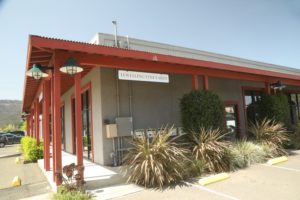
 Lewelling maintains a small tasting room in a one story complex of office spaces along Vidovich Lane in St. Helena. Lewelling moved into this space in 2021; it is a very short walk to one of their winery neighbors, the Clif Family tasting room and the Clif Family food truck which is often-parked curbside.
Lewelling maintains a small tasting room in a one story complex of office spaces along Vidovich Lane in St. Helena. Lewelling moved into this space in 2021; it is a very short walk to one of their winery neighbors, the Clif Family tasting room and the Clif Family food truck which is often-parked curbside.
Visits are by appointment and are typically hosted with Haley or her brother Neal. As of our latest update to this review, visitors are hosted on Thursdays and Fridays for indoor or outdoor seating. The space is also used for a limited number of Lewelling member events.
—
The wine is distributed in very select markets nationally (mostly high-end wine shops) as well as direct to consumer via a mailing list. Due to their small production and demand for the wine there is currently a waiting list. Wines are released once a year and are typically offered a year in advance of when they ship to mailing list members.
For more information about their current release wines and to join their waiting list, please visit: www.lewellingvineyards.com
Historical
These 4 photos courtesy of Haley, Lewelling Vineyards







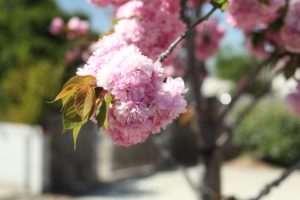



















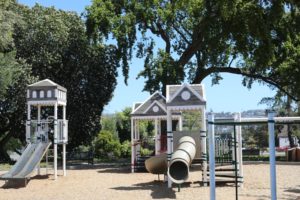


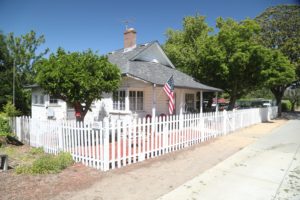















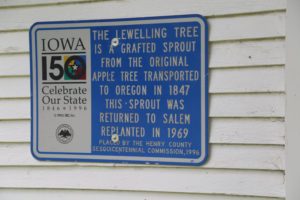


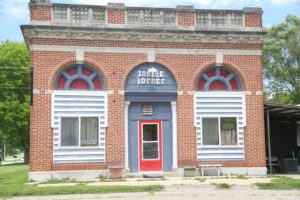

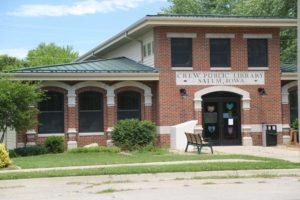









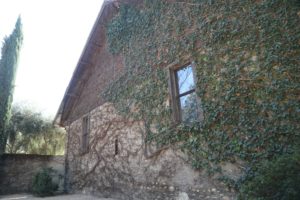
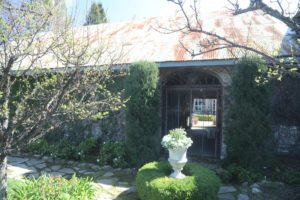



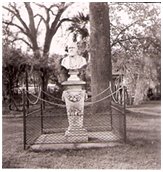


Good story but incomplete. The original Estate of John Lewelling still owned by their descendants, which makes it one of the oldest family owned farms in the Napa Valley. It is owned equally by two families, the Wights, mentioned in your article and the Taplins.
Taplins not only produce a beautiful Cabernet by winemaker Julien Fayard, but in honor of their sister Melinda a sought out Rose. They donate 100% of the profits from this wine to Breast Cancer Research. There is a lot more to the story….
This review obviously just focuses on Lewelling Vineyards. If you had spent any time on this site you would have seen our separate review on Taplin Cellars (who we also met with).